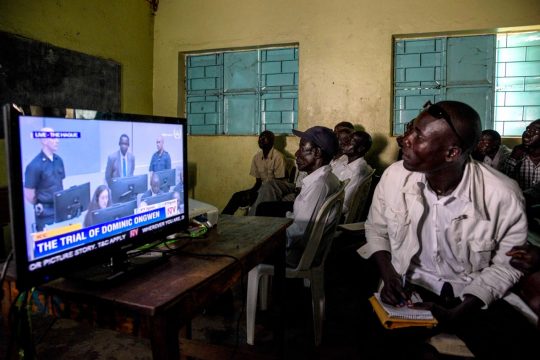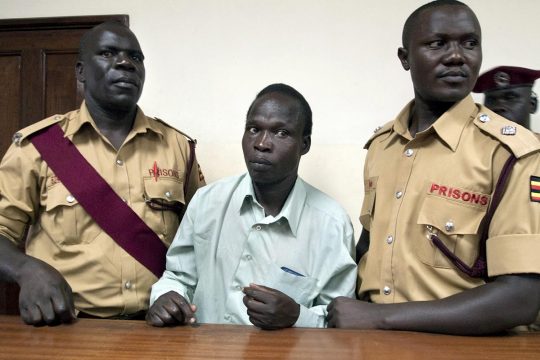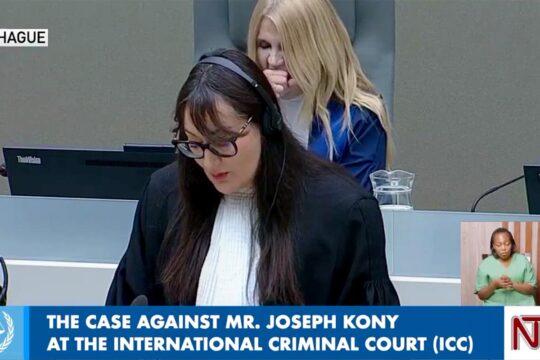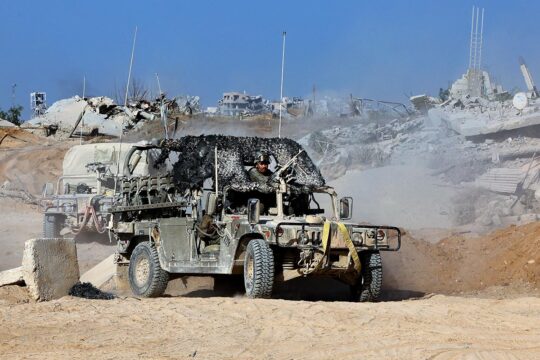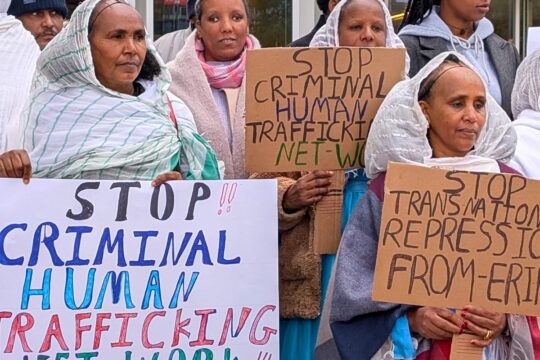From 10 to 12 March, about two dozen prosecutors, victim’s lawyers and defence counsels gathered in The Hague to present their closing arguments to three judges on how they ought to perceive Dominic Ongwen, a former Lord’s Resistance Army (LRA) child soldier who became one of its commanders, and whether or not to convict and punish him for a litany of atrocities he perpetrated after his eighteenth birthday. On one hand, Ongwen was portrayed as a monstrous, brutal and cruel serial-paedophile, a mass murderer and a fearless terrorist, who was powerful, proud and happily “gratifying his own desires” in the bush. On the other hand, he was represented as a youth who was victimised, orphaned, imprisoned, initiated, indoctrinated and incorporated into the LRA. Possessed by the spirits called upon by LRA headman Joseph Kony, he had become a madman with suicidal tendencies.
“I was in school. It was noon. A white van pulled up and took me and three friends. They tied my hands and legs and threw me in the truck. When we arrived at the camp, our training started with a beating. We were told if we tried to escape, we would be killed. We were forced to carry heavy supplies, and raid homes to get more. We were forced to steal. To kill. […] I was a boy of 12, now I am grown. I want to move on, but it’s like I am trapped. I cannot go back to school, cannot get a decent job, because no one trusts me. I want to start my life again.”
This tragic story told by an anonymous ‘African’ kid is a contiguous reminder of Ongwen’s first appearance at the ICC in early 2015. In a soft, uncomfortable voice – through translators - Ongwen told Bulgarian Judge Ekaterina Trendafilova that he was “taken to the bush when [he] was 14 years old” and was now “informed he was brought to the ICC because of crimes”. While both stories seem analogous, they are not. The first is an affective soundbite over an animated video produced by the ICC’s outreach office about the sad plight of former child soldiers. To illustrate the life-long, traumatic and lingering impact of being kidnapped in the bush only to be raised as a ferocious fighter, we see a caged bird; it is trapped for life but it wants to be free again. Towards the film’s end the viewer anticipates a moment of hope, liberation, salvation – some twist that is comforting. But there is no happy end. Rather a sense of astonishment, confusion and derailment is what follows when the story awkwardly transits to a young, white lady who sits at the ICC Public Gallery. Gazing through armoured glass into an ICC courtroom she sees the cage looming behind three magistrates. It is supposed to be a clear warning that child soldier enlisters, conscripters and users will be gaoled by international justice. But how does a former child soldier like Ongwen, a victim of such child abductors who later caused mass-suffering as an adult, fit the script?
Charges against the LRA
Let’s first try to grasp the charges. The 70 counts of war crimes and crimes against humanity which Ongwen allegedly committed through seven modes of liability are not just a world-record in international justice, they are also no child’s play. Forty-nine charges relate to attacks against civilians, murder, attempted murder, torture, cruel treatment, inhumane acts, enslavement, pillaging, outrages upon personal dignity, persecution and destruction of property during attacks on Internally Displaced Camps in Pajule, Odek, Lukodi and Abok between late 2003 and mid- 2004. Eighteen charges pertain to forced marriage, torture, rape, sexual slavery, forced pregnancy and outrages upon personal dignity perpetrated by himself against seven of his “wives” and by folks – including child soldiers - under his command. At the end of the list feature two charges of conscription of child soldiers. Although Ongwen was tried for atrocity crimes of which he was once a victim, his trial was not just about him; it was also about the LRA. It is the one thing Ongwen understood very well. “I did understand the document containing the charges but not the charges,” he told the judges on the first trial day in December 2016, “because the charges I do understand as being brought against LRA but not me. The LRA is Joseph Kony, who is the leader of the LRA.” And indeed, from the beginning and throughout their case the prosecution clearly said that “for more than a quarter of a century, the LRA under Joseph Kony and his high command, that includes Ongwen, have terrorised the people of Northern Uganda and neighbouring countries” and that the time for a grand judicial reckoning with the infamous group had finally come.
With visible unease, the prosecutor told the Chamber that the principle of ‘once a victim, always a victim’ does not apply in Ongwen case
Benjamin Gumpert, who leads Ongwen’s prosecution agreed Ongwen had indeed been a victim of abduction; “it is a tragedy”, Gumpert admitted. But then he went to great lengths to paint a picture of Ongwen as an adult who became a willing, conscious and intentional tormenter. In Gumpert’s take on the story, Ongwen actually chose to stay in the LRA, presuming he had ample opportunities to escape. After three years of litigation, Gumpert – who previously led the withdrawn prosecution of Kenya’s President Uhuru Kenyatta and is now reportedly running for the Chief Prosecutor’s position – has to win a case while also maintaining a more general but contradictory stance towards child soldiers. With visible and at times audible unease, he told the chamber that the principle of ‘once a victim, always a victim’ does not apply in this case. You cannot have it both ways, he repeats, arguing Ongwen was a vigorous, effective, enthusiastic commander, who was described by prosecution witnesses as “anything other than happy and sociable”. Gumpert’s depiction of the former child soldier in the dock hardly matched with how three legal representatives of victims talked about the life-long consequences suffered by child soldiers. Francisco Cox told the chamber “our victims” – 4,065 in total, including many child soldiers – were scarred for life; they were stigmatised, discriminated against, dropped out of school, divorced and are at times still “infected by evil spirits, or cen” after they had returned home from the bush. Citing their expert witnesses (Michael Gibbs Wessells, Seggane Musisi and Daryn Scott Reicherter), it was as if the lawyers were describing the man they were actually ‘co-accusing’. But the contrary was also true. Paolina Massidda, principal counsel of the Office of public counsel for victims, said that Ongwen is that one and only exception, that when he obtained the age of reason he knew what unlawful, brutal harm he was proudly causing and that he was even doing so “with the intent to carry out grave violations of international law”. Ongwen’s lawyer, Krispus Ayena Odongo, in rebuttal, said the only laws Ongwen knew were Kony’s Ten Commandments.
Artificial legal boundaries
As much as child soldiers are imperfect victims, they also are tragic perpetrators, explains Mark A. Drumbl, the author of "Victims who victimise". In all the complexities of their social realities and experiences, child soldiers escape easy qualifications. They do not neatly fit the legal binaries of childhood or adulthood, guilt or innocence, victim or perpetrator, even more so when former child soldiers continue or even aggravate their crimes into adulthood, like Ongwen. It is striking that in international criminal law the transition from being ‘not responsible’ – a compromised child with little capacity to act – to potentially the ‘most responsible’ – an adult with full choice and capacity to act – for the most inhumane acts is so abrupt. From one day to the next, an individual can be transformed from an indisputable victim into a perpetrator. Thus, the boundaries between whom international criminal justice wants to protect the most from international crimes and whom it seeks to punish the most is abrupt, artificial and adversarial. Ongwen is both the ‘poster child’ and the ‘problem child’ of this legal and moral conundrum.
Perhaps the largest paradox in the Ongwen case is that both prosecutors and victims’ lawyers have portrayed Ongwen as an uncurable psychopath but at the same time deny he suffered from mental illness, trauma or post-traumatic stress disorder when he was causing atrocity – a diagnosis they otherwise effortlessly attach to the “30,000 abducted children in Uganda between 1986 and 2007”. As a matter of fact, Ongwen’s being in the dock diametrically clashes with the ICC’s universal message that children are, by default, the ultimate, the most vulnerable and most affected victims of atrocity crimes. At the end of the Thomas Lubanga trial in August 2011, which was all about child soldiers, Fatou Bensouda took on the role of maternal prosecutor, telling the trial chamber that “children need mothers, not commanders”. On 12 February 2019, she reiterated that “children with otherwise bright futures are lost to the violence, subjected to unimaginable atrocities, wrenched from the safety and security of their families, and deprived of the opportunity to grow and develop in a nurturing environment”. However, only twelve days later, Bensouda signed off the closing brief in her criminal pursuit of Ongwen, taking the most rigid view that “during the course of trial, he has sought to hide behind excuses involving mental illness and duress, which have been exposed as false.” Seemingly, the Ongwen saga is both the ICC’s success story and antithesis of what it stands for and fights against.
According to the defence, in the absence of Kony, the prosecution conducted a “proxy-prosecution” victimising Ongwen again and sending the overall message that “children will be prosecuted for the crimes of their captors.”
Obviously, this conflict, conundrum and confusion has been picked up, instrumentalised and exploited by Ongwen’s defence. The defence’s story was clear: Ongwen, they say, was an enslaved prisoner of the LRA until his escape in 2015; he was brutalised and ordered – by Kony and his spirits – to brutalise others. Lead counsel Odongo said Ongwen became a madman, who had no mind of his own and whose sole motive had become “dying”. Ongwen perceived death, Odongo said, as the ultimate escape from the LRA. The defence then turned against the prosecution, whose story is laughable, Odongo proclaimed, saying they portrayed Ongwen “arising from hell a saint and should be judged as a reasonable man”. Looking at Queen’s Counsel Gumpert, Odongo added that an English law professor once told him that the definition of a reasonable person “is a man on the streets of London” and not a child in the bush. Gumpert, sitting eight metres opposite, shrugged and smiled. Furthermore, the undertone of the defence’s allegation was that the prosecution, in the absence of Kony, conducted a “proxy-prosecution” through Ongwen, thus making him a scapegoat, victimising him again and sending the overall message that “children will be prosecuted for the crimes of their captors”. Instead of a vicious perpetrator, the defence concluded on 12 March that Ongwen is a mentally disabled child and a victim who actually ought to be represented by the victim’s lawyers and remedied by the ICC.
Ongwen himself remained silent through the closing arguments and all 231 hearings before it. Most of the time, he remained a stoic, introvert defendant, sitting straight up in his chair, hands folded, staring into the screens before him, occasionally scribbling in his red or green notebook, drinking water from a plastic cup. His lawyers refer to him as “that boy”. It is not a secret: in prison Ongwen has reportedly threatened to commit suicide, went on hunger strike and was forcibly removed from his cell at least once. During trial, he once flared up and was restrained by a security guard. The incident happened when a prosecution expert, forensic psychiatrist Gillian Clare Mezey, was giving her opinion about Ongwen’s mental state. Undoubtedly, Ongwen’s detention by the ICC and his trial have taken its toll. On arrival, Ongwen was a seemingly fit, muscled and slim young man; his suit was too big. His body, however, is also a canvas of scars. His leg was shattered and he limps. In the beginning, he was a quiet young man and enjoyed the easy-going prison conditions, his new company – an unusual group of Ivoirian, Congolese, Rwandan and Malian atrocity crime suspects – and education, including piano-lessons. Years and reportedly many antidepressants later, observers say he has put on a lot of weight, and his jacket buttons seems about to burst.
Whom to believe?
Defence lawyer Beth Lyons summed up the challenge facing the three judges, who are now deliberating: it is about answering the question “whom do you believe”. Witnesses, prosecution or defence experts or the court-appointed expert? Court-appointed psychiatrist Joop de Jong and defence experts Emilio Ovuga and Dickens Akena examined Ongwen first hand, each finding that Ongwen at least suffered from some level of major depressive disorder, post-traumatic stress disorder and other specified dissociative disorders. For the defence, Ongwen, who is now in his 40s, has a child-like, tormented state of mind and suffers from mental disability. While the prosecution’s experts Catherine Abbo, Mezey and Roland Weierstall-Pust would agree to some extent, the prosecution would not have it that Ongwen suffered from any mental deficiency when he was in the bush, carrying out the alleged crimes. And before Ongwen’s eyes, during the trial, the parties and even the experts themselves went for blood, with Gumpert calling Ovuga’s expert testimony “nonsense” and Weierstall-Pust – who had never met Ongwen - accusing the defence experts of delivering “sloppy” work.
Victim-perpetrators, what’s the ICC stand?
What the Ongwen trial shows is that international criminal justice’s reckoning with child soldiers has been problematic; while it proclaims to act in their best interests, its operational outcomes are less than satisfactory. As witnesses, for example, former child soldiers have often proved to be capricious, uncontrollable and susceptible to manipulation – sometimes recanting stories. Our research shows that in over 71 percent of instances involving (ex-)child soldier witnesses at international criminal tribunals and the ICC, judges identified fundamental problems with their testimonies. While questions as to their reliability, credibility, trauma and age began to undermine the very cases initiated to protect them, child soldiers’ legal victimhood was tested and contested too. During sentencing Lubanga, however, the harm inflicted upon a child soldier, by default, was presented and invoked by judges as very serious, long-lasting and irreparable. The child remains a victim for life, with his or her bygone experience and memories of atrocity continuing to inflict pain. In the Ongwen sentencing, if they convict him, judges will have the task of formulating the ICC’s stance towards victim-perpetrators.
The legal and moral threshold that marks the transition from an angel into a devil, and from the future of humanity to someone most responsible for the most heinous crimes, remains ambiguous.
The international legal and moral threshold that marks the transition from an angel to a devil remains ambiguous. Is that transitory moment just an 18th birthday? Unwillingly, the ICC has turned this theoretical puzzle into a real-time laboratory, attracting a wide range of commentary and reflection on responsibility, culpability or justiciability of individuals like Ongwen. On the one hand, it could be argued that any recognition of kidnapping or prior recruitment as a defence cannot overcome the gravity of the crimes such defendants allegedly perpetrated as adults. On the other hand, a case could be made to immunise ex-child soldier defendants from prosecution. A middle-ground position could be that recruitment as a child and its effects on an individual’s level of maturity and development is a mitigating factor when sentencing a convicted perpetrator.
Reintegrate Ongwen, says defence
For the prosecution, having suffered victimization in the past is not a justification nor an excuse to victimise others. Rather they argued, the ICC will not decide Ongwen’s goodness or badness, nor whether he deserves sympathy, but whether he is guilty of the serious crimes he committed as an adult. But Gumpert, while asking the chamber to convict Ongwen on all charges, also paraphrased his chief’s statement at the beginning of the trial that “we are not here to deny that Mr. Ongwen was a victim in his youth”, adding that “victimhood is to be considered during sentencing”. Curiously, all three legal representatives for victims remained silent on the issue – maybe saving it for sentencing hearings in case Ongwen is convicted. On their part, the defence asked the chamber to acquit “that child” in the dock, and that in the case of conviction he not be made to serve sentence “any longer”. Ongwen has been imprisoned by the LRA and in the ICC’s detention centre now for more than 30 years, they said. He wants to live again, they urged – like the boy in the ICC’s video – and in order to do so requested the chamber to send him “back to Acholiland so that traditional mechanisms of Mato Oput can be implemented” to reintegrate him into society. “The principle of complementarity empowers you,” Odongo told judges Bertram Schmitt, Péter Kovács and Raul Cano Pangalangan, “to think outside the box.”
 BARBORA HOLA
BARBORA HOLA
Dr. Barbora Hola is Senior Researcher at the Netherlands Institute for the Study of Crime and Law Enforcement (NSCR) and Associate Professor at Vrije Universiteit Amsterdam. She is co-director of the Center for International Criminal Justice and co-chair of the European Society of Criminology Group on Atrocity Crimes and Transitional Justice. A volume on “Perpetrators of International Crimes”, she co-edited, was just published by Oxford University Press.
 THIJS BOUWKNEGT
THIJS BOUWKNEGT
Thijs Bouwknegt is a historian and former journalist. He is a Researcher at the NIOD Institute for War, Holocaust and Genocide Studies in Amsterdam, The Netherlands, and Assistant Professor at the universities of Amsterdam and Leiden. His research focuses on the history of transitional justice, particularly in Africa. Since 2006, he attended and covered all ICC (pre-) trials in The Hague, including the Gbagbo and Blé Goudé case.



